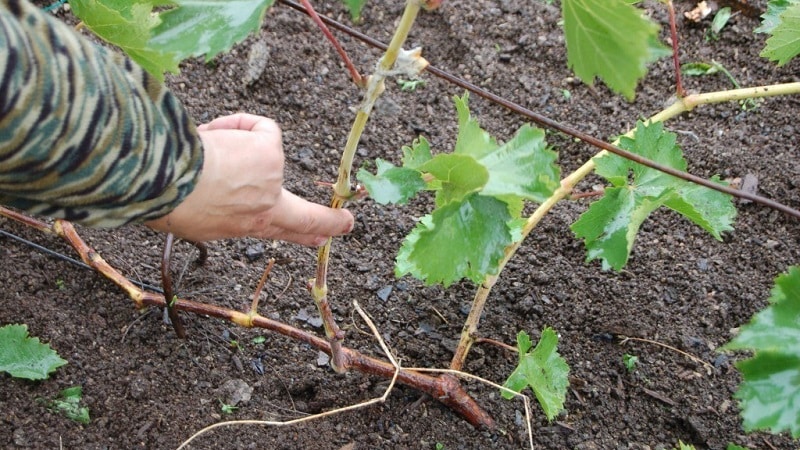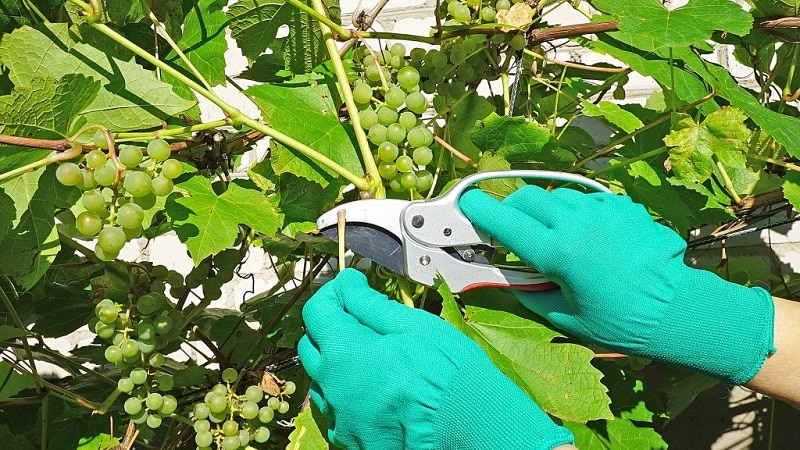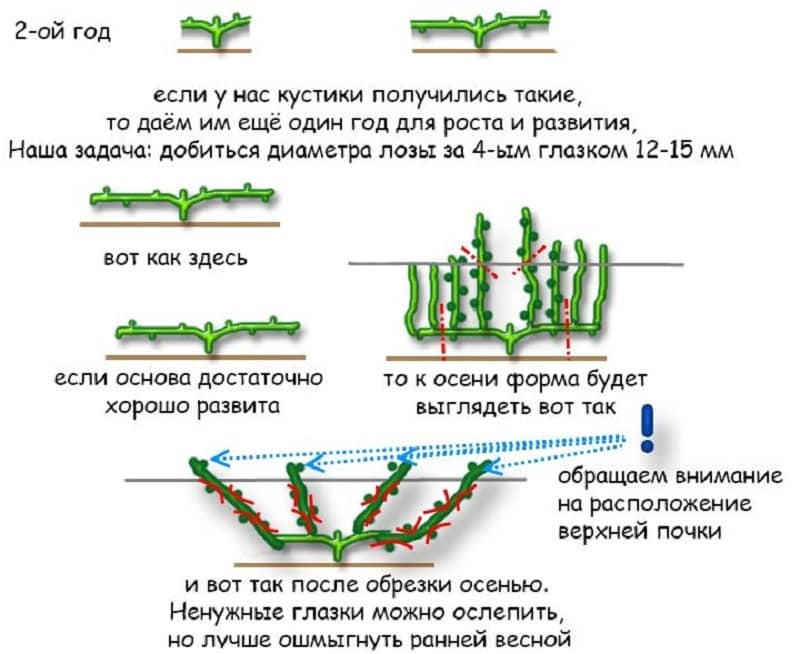A guide to pruning grapes in August in the Moscow region for beginning winegrowers
Pruning garden plants is a simple process, but has many nuances. For example, it is not always clear which vines are unnecessary and must be removed. However, there is no doubt about the advantages of pruning. With its help, the vineyard consistently bears fruit and produces a rich harvest. When to prune grapes in August and how to care for them after the procedure, we will tell you in the article.
Why prune grapes in August?
In August, young green vines are covered with brown bark, shoot growth slows down, and the lower part of the plant ripens. It is important to seize the moment and start chasing and pruning the grapes.
The procedures help the shrub to become more productive and strong, and the quality of the bunches improves. Plants get sick less in the future and are less likely to be attacked by insect pests. The root and aerial part of the plant develop evenly, making harvesting easier. Pruning is important for grapes of any age.

Is this necessary?
Pruning in August is mandatory if the gardener wants to have a healthy and productive vineyard. You can skip the procedure, the main thing is to return to it with the arrival of spring and trim the bushes immediately after the snow melts.
Sometimes August pruning is replaced with July pruning, but this is not always useful, especially for early and mid-ripening varieties, so August is considered the optimal time for the procedure.
Interesting things on the site:
Step-by-step instructions for grafting grapes in August
Pruning goals
Any pruning has a specific purpose. Using a rejuvenating procedure, gardeners remove old branches and make room for the growth of new shoots. This pruning improves the appearance of the vineyard; the bushes look neat and attractive.
You can understand whether a vineyard needs a rejuvenating procedure based on several signs: the bush has stopped developing or its growth does not exceed 15 cm per season. The event is carried out in 2 stages: first, the height of the crown is reduced, and then it is thinned out.
Sanitary pruning is aimed at strengthening the immunity of the bush after illness or get rid of insect pests. It is held annually in vineyards of any age. During the process, gardeners remove all dry, diseased and damaged shoots and leaves.
After pruning, be sure to spray the plant with prophylactic agents: copper sulfate solution, HOM preparation, Bordeaux mixture.
The purpose of formative pruning is to give the crown of the bush a neat appearance and increase its lifespan.. Summer residents remove shoots that grow downwards or to the sides, as well as branches with defects or damage. At the end of the procedure, the diameter of the crown becomes smaller by an average of 1-1.5 m. Conditions are created for the development of new and powerful branches.
Dates for the procedure in August in the Moscow region
In the Moscow region and the Moscow region, it is recommended to prune grapes at the end of the month (if we are talking about early varieties) and at the beginning (if middle and late varieties are grown).
The pruning procedure is stressful for the bush, so it is important that it does not coincide with the time of harvest.When choosing a date, they also rely on climatic conditions. The best option is early morning on a cloudy and warm day. Wind, rain and other precipitation on the day of pruning are unacceptable, so it is better to check the weather forecast in advance.

How to prune grapes correctly
To ensure that pruning of grapes in August in the Moscow region is successful, experienced winegrowers advise preparing the necessary tools in advance and studying the step-by-step instructions.
Required materials and tools
To trim young and green shoots, a flat bypass pruner with two curved blades is required. Such a tool does not deform the shoot, the cut remains smooth and heals quickly. It is recommended to trim branches at a slight slope.
If the shoots are old and dry, use contact shears. With its help, dry shoots up to 3 cm thick are carefully trimmed without damaging the fibers. When choosing a pruner, winegrowers pay attention to the material used to make the handle and blade. The best option is a steel blade and a thick rubber handle.
Use a lopper to trim thick branches.. Tools with long aluminum handles are easy to use. With their help it is easy to reach the highest vine. It is important that all garden tools are well sharpened and disinfected with a solution of potassium permanganate. Dull blades leave jagged cuts, making the vines slow to heal and more susceptible to fungi and viruses.
Step-by-step instructions for pruning grapes
After preparing the tools, gardeners begin pruning the branches.
Step-by-step instructions for beginners look like this:
- Remove all infected and diseased shoots, as well as weak and thin stems with a diameter of less than 5 mm.
- Leave only strong shoots more than 1 cm thick on the vine.
- Trim the vine back to living wood.
- Remove shoots and green shoots.
- Cut out branches growing down and into the crown.
- Lubricate the cut areas with garden varnish.
A popular question among summer residents: should I trim my mustache? On the one hand, they provoke the growth of the vineyard, with their help it clings to support. But if there is artificial support, the mustache can be trimmed.
Features of pruning depending on the age of the grapes
If the plant is more than 4 years old, it is recommended to start pruning from the bottom tier. Usually this is where most of the shoots and stepsons are formed. Gardeners leave up to 15 buds on the vine; the cuts should be turned inward, and not vice versa. A vine with several buds can be pruned, germinated and transplanted to a new location.
Young grapes begin to be pruned from the second year after planting. Particular attention is paid to ensuring that the cuts are made at an angle with sharp pruning shears. A young plant has a weak immune system, so it takes longer to recover after the procedure. If you trim the vines with blunt pruning shears, the wounds heal slowly and the plant weakens.

Post-procedure care
It is recommended to make cuts so that they are all on the same side. If the wounds are uneven, they are cleaned using a garden knife. Next, they are smeared with melted garden varnish - it helps the bush recover faster and prevents the development of diseases. If there is no varnish at hand, summer residents use cedar or pine resin. You can also prepare the following composition for processing grapes: 5 kg of rotted cow manure + 2.5 kg of slaked lime + 500 g of fine sand.
5-7 days after the procedure, the vineyard is inspected. If all the wounds have healed, there are no cracks or other damage, the plants are sprayed with a solution of Quadris or Arrivo. They protect plantings from mildew, scab and powdery mildew. The treatment is carried out in dry weather, after watering the bushes abundantly.
Read also:
Is it possible to plant different grape varieties side by side?
Advice from experienced winegrowers
For pruning to bear fruit, it is recommended to follow advice and recommendations from experienced Russian winegrowers:
- cut the shoots in the direction of the upper eye;
- make sure that there is at least 2 cm of living vine above the bud;
- do not trim diseased bushes - they must first be cured;
- remove inflorescences that formed during the summer;
- do not leave circumcised stepsons on the ground - they cause diseases;
- If you didn’t have time to prune the grapes in August, do it in the fall (before the onset of winter).
Conclusion
Pruning is an integral procedure in grape farming. There is rejuvenating, thinning, and formative pruning. Thanks to them, the bushes grow strong and productive.
During pruning, gardeners remove diseased, dry and damaged shoots. Such vines no longer bear fruit, but take food from healthy branches. After the procedure, the sections are lubricated with garden varnish so that the wounds heal faster. The procedure is carried out annually, starting from the second year of the plant’s life.